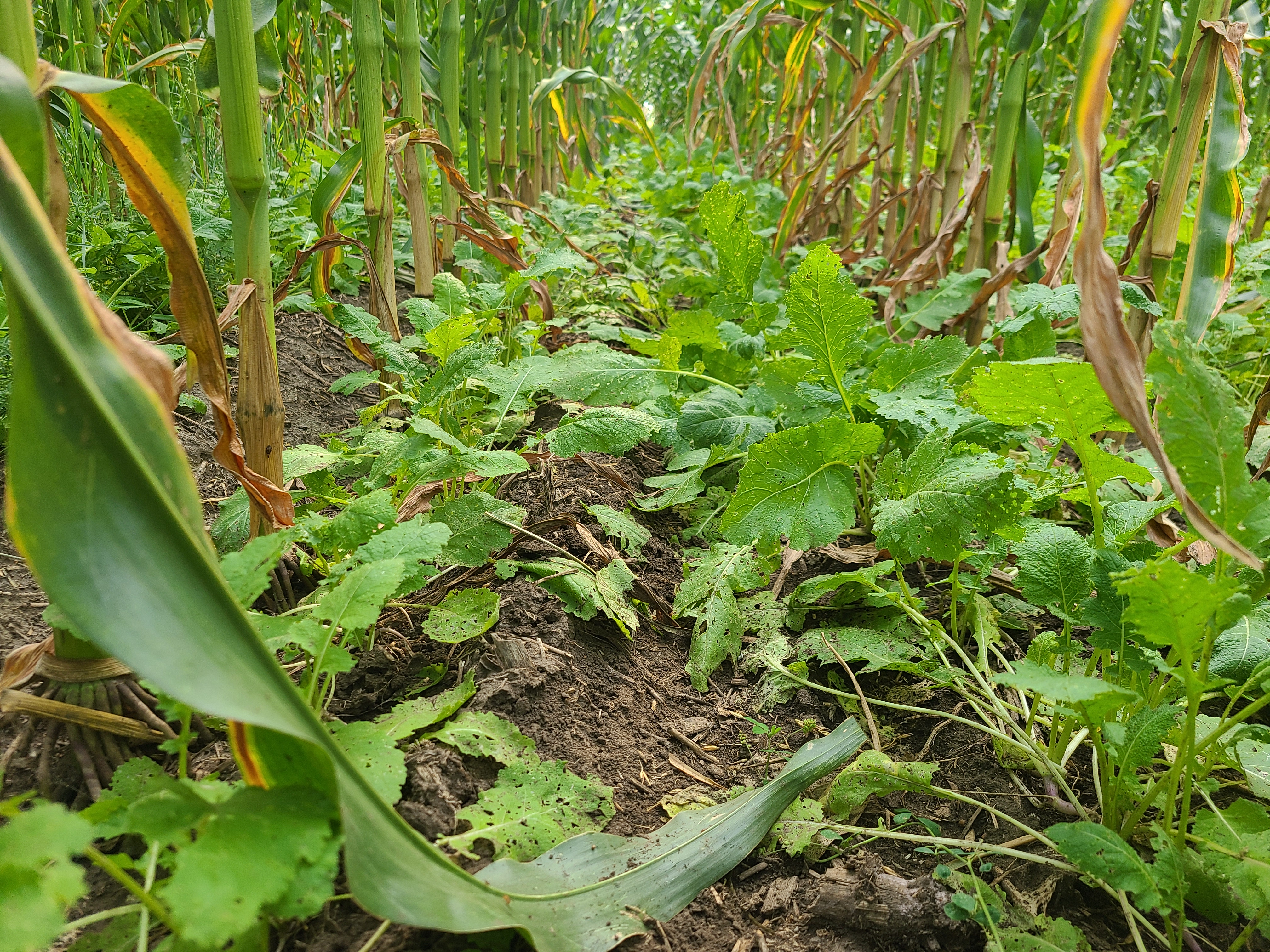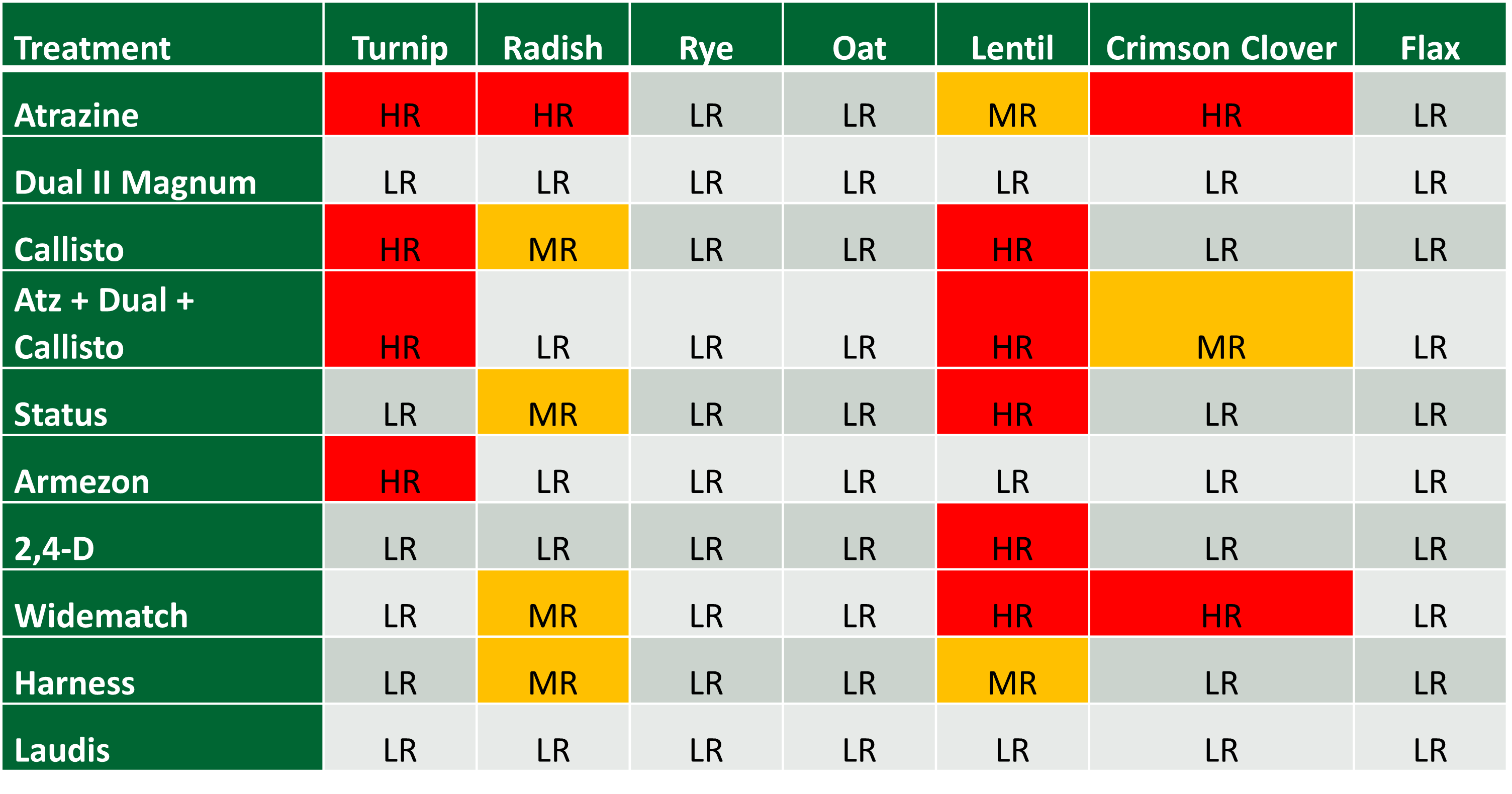Cover crop adoption in the Northern Great Plains is often limited by a combination of low moisture, short growing season length, and the overlapping of planting windows with harvest season. These are difficult to overcome in a traditional fall cover crop system that follows harvest of a cereal or cool-season legume. Winter rye has been one of the more successful cover crops in the Northern Great Plains due to its wide planting window, a growing season that requires winter, and easy emergence under most conditions. However, fall-planted winter rye comes with many other risks when preceding a crop like corn. Some of the major risks include high early spring water-use and nutrient tie-up. Other options may be preferred in most cropping systems.
Previous research at the CREC and elsewhere has demonstrated that cover crops of various species can be successfully planted between the corn rows mid-season with a high establishment success rate and minimal risk to corn yields. This overcomes the limitations of low fall moisture and short growing season. Cover crops can be readily established between corn rows when planted or drilled. Broadcast seeding cover crops can also be done at this stage but the success rate is much lower compared to the seed-soil contact that planting provides. A reliably established corn cover crop would be especially important to livestock producers. Fall, winter, or spring grazing after corn, with other species growing between rows, would make a great addition nutritionally for the animals and likely extend the grazing period of the land. Be sure to check herbicide labels for grazing restrictions.
From a cropping systems perspective, mid-season cover crops have some logistical concerns that need to be addressed. In particular, one needs to be very familiar with how a weed management program is going to interact with a cover crop planting. On one hand, effective herbicides should be utilized as to not sacrifice weed control. Glyphosate-resistant weeds are too common to rely on glyphosate alone. But on the other hand, residual herbicides are likely to impact at least some of the cover species of interest.
Methods
Between 2021 and 2023 trials were conducted near Carrington and Prosper, ND to determine the effect of corn residual herbicides on common cover crop species. Herbicides were applied around corn growth stages V3-4 each year, and cover crops were planted 10-14 days later (v4-5) with a modified planter that goes between the corn rows. In all, ten herbicides and a check, and ten cover crops were tested in all combinations and replicated three times in each site-year. Each plot was evaluated three and eight weeks after planting to determine differences in cover crop emergence and survival. Ratings were then categorized for simplicity. If an herbicide reduced cover crop emergence by 20% or less it was considered a low risk product for that cover crop. If the reduction ranged from 21-50% it was considered medium risk. If the reduction was greater than 50% it is a high-risk (HR) combination. At each site and year, ratings were combined to get an average rating for each combination. The highest rating of each combination across sites was then used to generate the final table. So essentially, if even one of the sites had an injury rating above 50%, then that treatment combination would be categorized as high risk, and for a combination to maintain the low-risk (LR) label it means there were no instances in all the trials when injury rose above 20%.
Effect of corn residual herbicides on cover crops.
Results
As Figure 1 illustrates, a number of herbicide and cover crop combinations will not be recommended. Several of the tested herbicides are very effective broad spectrum residual products. Even products such as 2,4-D have a short duration residual component which caused substantial injury to lentils. Lentils in particular serve as a good indicator of potential herbicide carryover issues, and in this study only three of the tested products caused little to no injury. The surprising aspect is that Armezon and Laudis were two of the products which did not impact the stand. These products have long residuals which often impact cool-season legumes the following season. However, it is believed that if the lentils were allowed to grow as a cash crop then injury would occur, but as an understory cover crop there was not enough growth and biomass to impact the production. Carryover damage from this family of herbicides often does not show up until the bloom stage in legumes. As lentils are one of the more herbicide-sensitive, cool-season legumes, it can be reasoned that other cool-season legumes are likely to be more tolerant of nearly all herbicides. Unfortunately, the scale of the study made it extremely difficult to test all cover crop species of interest. After lentils, turnips were the next most sensitive species, followed by radish and crimson clover.
Winter rye, oats, and flax had little to no observable injury to the products. When incorporating cover crops into corn, these would make a good base for potential species mixes. Herbicide programs could be molded to work with other desired species (such as a legume), or cover crop species could be altered to fit the existing programs. It should be noted that when used in this manner, oats and other spring cereals like barley will head out as an understory species. Since the winter rye would be planted late June-early July it would not head out until the following season. Radish would also potentially produce seed as an understory crop. Both radish and turnip are susceptible to flea beetles. If the radishes are small at the time of regional canola swathing/harvest then it could result in substantial damage as flea beetles migrate to greener material.
Figure 1. Relative risk of cover crop injury when residual herbicides were applied at least 10 days prior to cover crop planting. LR = Low Risk (0-20% injury); MR = Medium Risk (21-50% injury); HR = High Risk (51-100%).
This dataset is meant to be a starting point for cover crop and herbicide decision-making. Soil texture and chemical property variability, weather patterns, and the planting operation could create observations that occur in contrast to this table. In fact, in many cases, even combinations which are listed as high risk in the table may cause minimal injury ‘most’ of the time. Also, when serving as a cover crop, some level of injury may be acceptable to an operations’ goals. For instance, if a cover crop is 25% less productive (MR), it may still achieve some goals such as ground coverage or forming a deep taproot. Most goals would fail if injury escalates above 50%.

